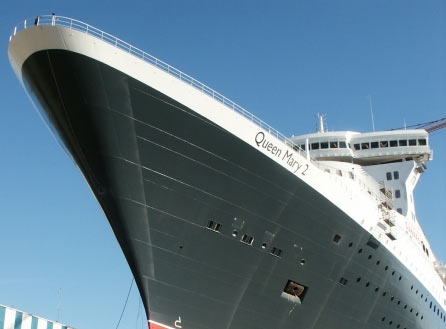 “She is a ship for the sea,” said Stephen Payne, director of project management at Carnival Corporate Shipbuilding in London and the designer and senior naval architect for the QM2. He is also responsible for the site teams for Carnival Cruise Lines, Costa Crociere, Cunard Line, and Holland America Line at five different yards.
“She is a ship for the sea,” said Stephen Payne, director of project management at Carnival Corporate Shipbuilding in London and the designer and senior naval architect for the QM2. He is also responsible for the site teams for Carnival Cruise Lines, Costa Crociere, Cunard Line, and Holland America Line at five different yards.
“The QM2 is designed specifically to go transatlantic at speed any time of the year. She has the necessary reserve power to go through a storm or to divert and go around,” Payne continued.
“We could have opted to build a cruise ship that looked like a liner and would probably be fast enough in August. My concern is that the liner service would be popular, and then stretch into the fall months, when the Atlantic can turn bad.
“A cruise ship is only second best in the Atlantic,” he added.
Strength to Go Through Storms
The QM2 has the strength and the structural integrity to go through storms, according to Payne, who explained that Cunard Line has specified a fatigue life of 40 years. That means that this ship shall be able to sail for 40 years without any undue structural degradation.
Lloyd Register of Shipping (LR) was given the task of analyzing the structure of the ship, studying how the ship will bend and flex, and recommended increased thickness of steel plates and tighter structural webbing.
While it was mostly LR that identified ways to modify the structure to ensure longevity, the yard took the extraordinary step of changing its building methods to meet the new specifications.
A tremendous amount of model testing was also carried out at Marin, which looked at all the propulsion data, the seakeeping data, and the effects of different waves and weather, and built a simulation model. The model included five-years of satellite weather data for the North Atlantic. Simulation runs not only covered those five years, but two to three different routes, according to Payne.
The conclusion was that the QM2 has the right power and characteristics to ensure her arrival and departure every six days when she sails transatlantic and is allowed a 10-hour turnaround. In the past, transatlantic liners were usually allowed two to three days in port, having a built in safe-zone in case of bad weather.
Analyzing the seakeeping data, Payne said that the QM2 was “twice as good as the QE2” under the same weather and sea conditions.
To ensure uninterrupted service, the QM2 has split engine rooms, with her main diesel engines situated deep down below the funnels, and the two gas turbines higher up. Her control systems are also backed up so that no single point of failure will disable the ship. She also has four pods instead of two.
Crossing at 25 Knots
When crossing, the QM2 will travel at a very respectable 25 knots, but only use 60 percent of her available engine power. Her engines generate enough power for the entire city of Southampton, according to Payne.
Smooth sailing is also ensured by her block coefficient which is 0.61 compared to 0.73 for most cruise ships. (The closer the block coefficient is to one, the more the hull resembles the shape of a brick moving through the water.)
“We did a coast-to-stop test starting at 29 knots,” Payne explained. “It took 45 minutes before she stopped. She really cuts through the water and the bow wave is nearly non-existent.”
Thruster doors also help the QM2 cut faster through the water. If it were not for the doors, the thrusters would act as scoops, and presumably generate a significant drag.
The stabilizers are a moot point as far as speed is concerned, Payne explained. “If you run them in calm seas, they will slow you down,” he said. “If you use them in a storm, there will still be drag, but that is offset by keeping the ship more stable, creating a better environment for the propulsion.”
Interviewed only weeks before the QM2 was due to sail, Payne said: “I have this philosophy that to get things right the first-time, you need to have an appreciation for history – of what has been done before.” Thus, he borrowed some concepts from previous liners for internal and exterior design – such as the breakwater from the Normandy as well as the split engine room.
The stern is a hybrid between liners and cruise ships. Payne explained that liners have cruisers’ sterns, which look nice and have good seakeeping characteristics, while transom sterns are good for more efficient propulsion, but often cause slamming whereby waves will literally “slam” up underneath. Hybrid sterns have previously been used on the Oceanic and the Eugenio C.
Rather than the box-shape of modern cruise ships, the QM2 is pyramid-shaped, putting the weight in the middle where the structure is strongest, Payne explained.
The QM2 will also have a wrap-around promenade deck with the forward area glass enclosed.
During sea trials, what impressed Payne the most was the almost complete lack of noise and vibration at 29 knots. “I walked around with a bottle of water to see if there would be any ripples wherever I put it down. But it was calm like a milk pond,” he added. “I have never seen that on any other ship.”
The biggest challenge was to design a transatlantic liner “at a price that could be built within a strict budget and generate enough return to make it worthwhile,” Payne said. – Oivind Mathisen
Excerpt from the Cruise Industry News Quarterly Magazine: Winter 2003-2004




